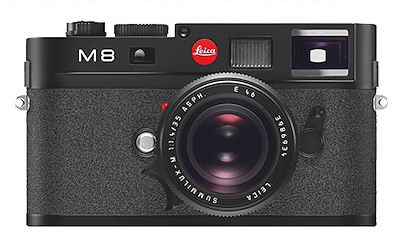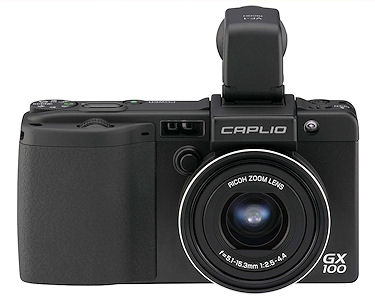As a technology watcher, I pay attention to what is going on in digital cameras.
Oh, this new camera itch! Just a year or two after you bought the camera of your dreams, new models are unveiled. The manufacturers want you to believe that this time they've got everything, everything right, and you won't be a good photographer until you get their newest product! Rarely, however, something really new and different shows up. Olympus had its share of break-through products (of which the E-10 and E-330 were perhaps most notable), but this year is rather uneventful, I dare say.
(What? With the Canon EOS Mk. III, new offerings from Nikon and Pentax, and, last but not least, the image-stabilized E-510 from Olympus, adding a live preview — uneventful? True, we've got some quite attractive new models, mostly SLRs, on the market, but they are "only" incremental improvements to what we have seen before: no new technologies or solutions. Maybe the new Jupiter III image processing engine is much better than Jupiter II, but for me it is more of the same. As good as all the new gear may be, this is not what I want to write about.)
From where I stand, perhaps the most interesting recent introduction, even if most of us cannot afford it, is the new, digital Leica M8 of last September. This is not just because someone put a digital sensor in a Leica body (a real one, not another camera with the Leica stamp on it); the M8 has some unique new features which may affect the evolution of digital camera technology.

The first one is the sensor itself, made by Kodak, with the individual photosites (or rather their microlenses) angled differently, depending on their distance from the optical axis. This greatly reduces the non-uniformity of effective exposure with existing Leica lenses which were not designed for digital medium. (Remember that non-SLR lenses do not have to leave an extra space for the swinging mirror, therefore they do not have to use the inverted telephoto design, in which the whole lens is moved forward with respect to its principal points and to the image plane.) To put it shortly, legacy lenses, especially wide-angle ones, should work better on Leica than on other cameras.
A grain of salt is that the M8 image size is 19x27 mm, or 75% of the full 35-mm frame, therefore the focal length multiplier is 1.33; for example, a 21 mm wide-angle lens on this camera will provide the same field of view as a 28 mm one on a film-based M7. Actually, the highly acclaimed, if not revolutionary, Canon EOS 1 Mk. III suffers from the same problem, with the same frame size.
The second news in the M8 is the absence of the antialiasing filter, used in all other digital cameras I know. This is a filter, placed just in front of the image sensor; its purpose is to diffuse the image just a little (read: introduce some loss of sharpness), in order to avoid the Moiré effect.
A short reminder: this effect occurs when two periodic patterns (stripes, grid) of similar, but not equal spacing, overlap. The effect is another periodic pattern, with frequency equal to the difference of the original ones (frequency is one divided by the spacing). You can see this effect looking through two layers of semi-transparent fabrics, differently stretched. In digital photography this happens when the periodic structure of the CCD is overlaid with a series of vertical or horizontal stripes spaced (in the image plane) at the distance slightly larger (or smaller) than the pixel pitch. (This may be not quite accurate, as the issue is further complicated by the RGB matrix on the sensor.)
Anyway, the simplest way to avoid Moiré patterns is to make sure that the image is not too sharp (less sharp than the nominal sensor resolution). This is what the antialiasing filter does. Leica lenses are known for their high resolution; this is why the designers decided to do something nobody else dared: getting rid of the resolution-degrading filter, and handling the antialiasing entirely in the firmware. For better or worse, a bold move.
This, unfortunately, had one negative side effect. In most cameras the antialiasing filter also cuts off the infrared component of light. Leica's sensor turned out to be too sensitive to IR, and this led to problems with color rendition, at least under some circumstances. These were discovered after the camera release, and Leica remedied the situation by sending free anti-IR, screw-on filters to all registered owners of the camera (in addition to firmware tweaks). I am not sure about people who use multiple lenses with different filter threads -- but what is an extra $100 compared with the $5000 price for the body alone? (Well, I would be happy having these problems.)
Oh, yes, the M8 focuses only manually, with use of the classic Leica rangefinder, and the optical viewfinder is like nothing you've seen since the Sixties. A purist's delight.
If we are at antialiasing, two more things come to mind. First, a random (or pseudo-random) sensor pattern would be free of the Moiré effect, but this is not feasible with the digital medium (it worked great with the film emulsion!). Second, increasing the sensor resolution even beyond the resolution provided by the lens may make sense: smaller pixel pitch requires less antialiasing! Maybe the megapixel race is not actually over? (What about noise, you may ask. Not an issue: while the per-pixel noise, indeed, may be inversely proportional to the pixel pitch, or to the square root of pixel area, the per-area noise should remain the same, and this is what counts when viewing the picture, unless you are pixel-peeping in full scale.)
All right, most probably you will not run to the store to get a M8, and very few people will. Still, we can learn from what Leica is doing. And if you would like to try street photography with a rangefinder-like camera, there may be other non-trivial options which will not break your budget.
One is the Ricoh Caplio GX100. I've handled it only briefly, but I liked it a lot, enough to forgive it being an EVF camera. Very attractive shape and feel, nice controls and diminutive size.
